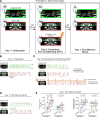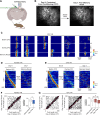A contextual fear conditioning paradigm in head-fixed mice exploring virtual reality
- PMID: 40525399
- PMCID: PMC12173461
- DOI: 10.7554/eLife.105422
A contextual fear conditioning paradigm in head-fixed mice exploring virtual reality
Abstract
Contextual fear conditioning (CFC) is a classical laboratory task that tests associative memory formation and recall. Techniques such as multi-photon microscopy and holographic stimulation offer tremendous opportunities to understand the neural underpinnings of these memories. However, these techniques generally require animals to be head-fixed. Few paradigms examine contextual fear in head-fixed mice, and none use freezing-the most common measure of fear in freely moving animals-as the behavioral readout. To address this gap, we developed a CFC paradigm for head-fixed mice using virtual reality (VR). We designed an apparatus to deliver tail shocks while mice navigated a VR environment. We tested three versions of this paradigm and, in all of them, observed increased freezing, particularly on the first trial, in the shock-paired VR compared to a neutral one. These results demonstrate that head-fixed mice can be fear-conditioned in VR and exhibit context-specific freezing behavior. Additionally, using two-photon calcium imaging, we tracked large populations of hippocampal CA1 neurons before, during, and following CFC. As in freely moving mice, CA1 place cells remapped and developed narrower fields following fear conditioning. Thus, our approach enables new opportunities to study the neural mechanisms underlying the formation, recall, and extinction of contextual fear memories.
Keywords: fear conditioning; mouse; neuroscience; place cells; two-photon imaging; virtual reality.
© 2025, Krishnan, Dong et al.
Conflict of interest statement
SK, CD, HR, DM, CC, MS No competing interests declared
Figures














Update of
-
A contextual fear conditioning paradigm in head-fixed mice exploring virtual reality.bioRxiv [Preprint]. 2025 Apr 13:2024.11.26.625482. doi: 10.1101/2024.11.26.625482. bioRxiv. 2025. Update in: Elife. 2025 Jun 17;14:RP105422. doi: 10.7554/eLife.105422. PMID: 39651122 Free PMC article. Updated. Preprint.
Similar articles
-
A contextual fear conditioning paradigm in head-fixed mice exploring virtual reality.bioRxiv [Preprint]. 2025 Apr 13:2024.11.26.625482. doi: 10.1101/2024.11.26.625482. bioRxiv. 2025. Update in: Elife. 2025 Jun 17;14:RP105422. doi: 10.7554/eLife.105422. PMID: 39651122 Free PMC article. Updated. Preprint.
-
A thalamic-hippocampal CA1 signal for contextual fear memory suppression, extinction, and discrimination.Nat Commun. 2023 Oct 24;14(1):6758. doi: 10.1038/s41467-023-42429-6. Nat Commun. 2023. PMID: 37875465 Free PMC article.
-
Andrographolide increases adult hippocampal neurogenesis and prolongs contextual fear memory.Psychopharmacology (Berl). 2025 Jun 27. doi: 10.1007/s00213-025-06832-9. Online ahead of print. Psychopharmacology (Berl). 2025. PMID: 40576679
-
Assessing the comparative effects of interventions in COPD: a tutorial on network meta-analysis for clinicians.Respir Res. 2024 Dec 21;25(1):438. doi: 10.1186/s12931-024-03056-x. Respir Res. 2024. PMID: 39709425 Free PMC article. Review.
-
Remapping Body Representation Using Virtual Reality in Chronic Neuropathic Pain: Systematic Review.J Med Internet Res. 2025 Jun 3;27:e71074. doi: 10.2196/71074. J Med Internet Res. 2025. PMID: 40341015 Free PMC article. Review.
References
MeSH terms
Associated data
Grants and funding
LinkOut - more resources
Full Text Sources
Research Materials
Miscellaneous

